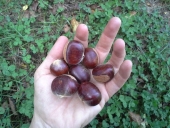First, "know thine enemy", the curculio nucum
https://en.wikipedia.org/wiki/Curculio_nucum
When they are inside the nut, it is a bit late and you can't kill them. As I see it,
there are 2 "choke points" in its life:
Early in the spring and late in the fall, they are
outside of the nut and susceptible to predators such as chickens/ other bug eaters. They overwinter underground, under the hazelnut bushes and come out when the temperature reaches 20 Celsius/ 60 Fahrenheit. That gives you the time of attack. That is true of bushes [wild American hazelnuts]. Cultivars can grow into trees and it seems that their schedule for flowering is a bit different.
https://www.wcngg.com/2020/02/03/choosing-planting-and-pruning-hazelnut-pollinizers/#:~:text=Hazelnut%20fertilization%20is%20a%20unique,3%2D5%20months%20after%20pollination!
At emergence, they are sluggish and immature & start climbing towards the hazelnut flowers, eating on the leaves along the way,
then mate.
Hazelnuts are
wind pollinated. They are monoecious, [male and female flowers on the same bush/ branches], yet they are self incompatible: they need cross pollination.
The catkin [male pollen givers] come out the previous fall but are not ready to release their pollen until they acquire their full length and flexibility and
pollen starts shedding in the spring of the following year!
The female flower has a gorgeous fuchsia color but is very small and hard to see.
Curculio nucum will not attempt to reach that flower [where the nut will be] until after you see the female fuchsia flower. That gives you several clues that the attack by Curculio Nucum is imminent:
*
Temperatures of 60F
*
Catkin fully extended and flexible, shedding pollen.
*
Female Fuchsia flower visible.
All 3 must be present for Curculio Nucum to start doing its damage. The larvae of the egg deposited in the female flower will eat the nut for about one month, then dig its way out & drop to the ground, leaving a small tell tale 1/16" hole in the empty nut.
It will winter 3-5" underground.
How can we take advantage of its life cycle? The actual calendar dates vary with the subspecies of hazelnuts and with your climate, that is why I went in great lengths into the cycle of the hazelnut plant and the cycle of Curculio Nucum.
Counter attack:
1/ As soon as the temperature reaches 60F, send in the
chickens scratching around the bushes, they will expose [and eat] a number of these emerging youngsters,
before they mate.
2/ let them have their fill until you no longer see the fuchsia color on the bush [at that time, the flower is fertilized, the nut is starting to grow and if a curculio nucum is inside, it is too late:
The female flower closes over the nut and is safe from any intervention, chemical or otherwise.
3/ As the nuts are starting to swell a bit,
some will fall to the ground: they have been attacked and
are infested. Just like you remove fallen apples so their parasites are removed from your orchard, so too should you remove these nuts that "don't make it".
4/ This would be the time to apply organic chemicals
directly to the ground if you feel you must. Whether fungus like Beauveria Bassiana or chemicals
they are designed to kill arthropods [animals with an exoskeleton] like our
honeybees.
5/ as Curculio Nucum falls to the ground and gets ready to bury itself before winter, now is another good time to
help your chickens get extra protein by disturbing the soil, close to your bushes. chickens can only claw so deep and may not get all of them.
As the snow falls and the ground freezes you can rest assured that there will be less
of these pests on next year's crop. Now, that leaves squirrels! Here, again, "Know thine enemy".
https://animals.howstuffworks.com/mammals/squirrels-really-organize-nuts.htm

 3
3




 4
4




 1
1





 2
2








 . That's an idea actually.
. That's an idea actually.
 2
2








 4
4




 1
1




 1
1




 4
4




![Filename: Leimring1.jpg
Description: [Thumbnail for Leimring1.jpg]](/t/171835/a/168146/Leimring1.jpg)
![Filename: Leimring2.jpg
Description: [Thumbnail for Leimring2.jpg]](/t/171835/a/168147/Leimring2.jpg)
![Filename: Leimring3.jpeg
Description: [Thumbnail for Leimring3.jpeg]](/t/171835/a/168148/Leimring3.jpeg)
 3
3




 1
1











